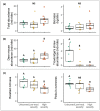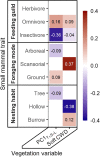Small mammal responses to fire severity mediated by vegetation characteristics and species traits
- PMID: 35600681
- PMCID: PMC9120878
- DOI: 10.1002/ece3.8918
Small mammal responses to fire severity mediated by vegetation characteristics and species traits
Abstract
The frequency of large, high-severity "mega-fires" has increased in recent decades, with numerous consequences for forest ecosystems. In particular, small mammal communities are vulnerable to post-fire shifts in resource availability and play critical roles in forest ecosystems. Inconsistencies in previous observations of small mammal community responses to fire severity underscore the importance of examining mechanisms regulating the effects of fire severity on post-fire recovery of small mammal communities. We compared small mammal abundance, diversity, and community structure among habitats that burned at different severities, and used vegetation characteristics and small mammal functional traits to predict community responses to fire severity three years after one mega-fire in the Sierra Nevada, California. Using a model-based fourth-corner analysis, we examined how interactions between vegetation variables and small mammal traits associated with their resource use were associated with post-fire small mammal community structure among fire severity categories. Small mammal abundance was similar across fire severity categories, but diversity decreased and community structure shifted as fire severity increased. Differences in small mammal communities were large only between unburned and high-severity sites. Three highly correlated fire-dependent vegetation variables affected by fire and the volume of soft coarse woody debris were associated with small mammal community structures. Furthermore, we found that interactions between vegetation variables and three small mammal traits (feeding guild, primary foraging mode, and primary nesting habit) predicted community structure across fire severity categories. We concluded that resource use was important in regulating small mammal recovery after the fire because vegetation provided required resources to small mammals as determined by their functional traits. Given the mechanistic nature of our analyses, these results may be applicable to other fire-prone forest systems, although it will be important to conduct studies across large biogeographic regions and over long post-fire time periods to assess generality.
Keywords: community structure; fire severity; functional trait; resource use; small mammal.
© 2022 The Authors. Ecology and Evolution published by John Wiley & Sons Ltd.
Figures





References
-
- Agee, J. K. (1998). The landscape ecology of western forest fire regimes. Northwest Science, 72, 24–34.
-
- Andersen, D. C. , & MacMahon, J. A. (1985). The effects of catastrophic ecosystem disturbance: The residual mammals at Mount St. Helens. Journal of Mammalogy, 66(3), 581–589. 10.2307/1380942 - DOI
-
- Apigian, K. O. , Dahlsten, D. L. , & Stephens, S. L. (2006). Fire and fire surrogate treatment effects on leaf litter arthropods in a western Sierra Nevada mixed‐conifer forest. Forest Ecology and Management, 221(1–3), 110–122. 10.1016/j.foreco.2005.09.009 - DOI
-
- Beauvais, G. P. , & Buskirk, S. W. (1999). Modifying estimates of sampling effort to account for sprung traps. Wildlife Society Bulletin, 27, 39–43.

